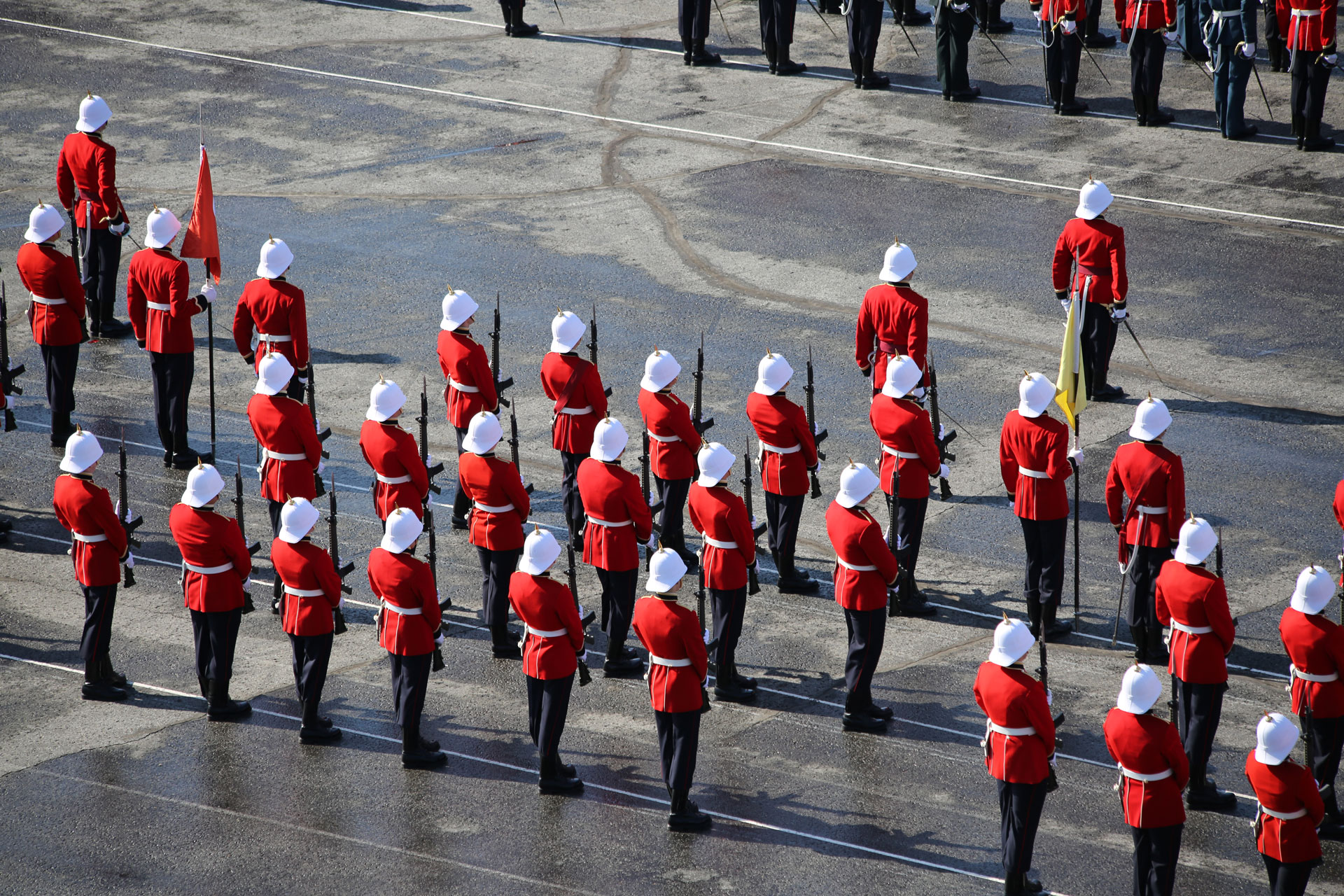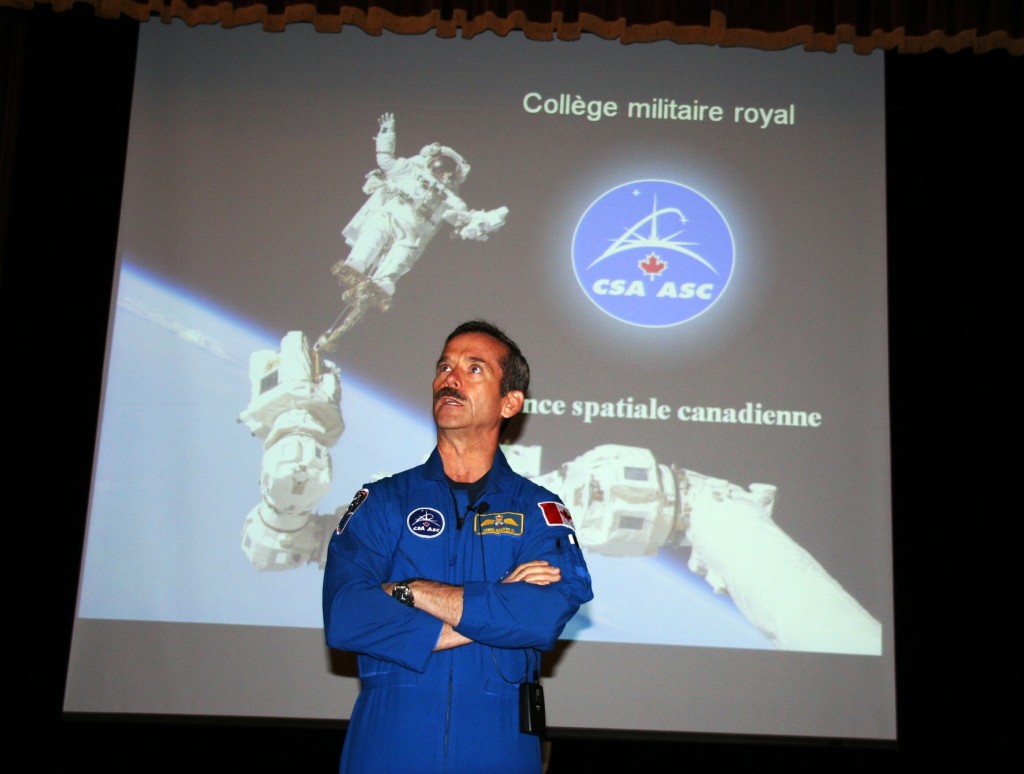
Currie Hall Packed to the Rafters for Chris Hadfield
Article By: OCdt 25323 Kate Haddon – Photos by OCdt Dan Flemming
I had the privilege of corresponding with 13738 Chris Hadfield , an ex-cadet of the college, as well as sit in on his lecture given today, April 14th 2011, discussing his training for Expedition 34/35, during which he will become the first Canadian to command the International Space Station.

His lecture was very informative about all aspects of space. As he showed Currie Hall pictures from space, you couldn’t help but feel intrigued. He gave the presentation in a way that showed who he was, how he felt about being an astronaut, while also showing his great sense of humour. He credited RMC and the training he received while in the military multiple times throughout, obviously an advocate and great supporter of RMC and the CF.
We, at e-Veritas, wanted to know more about his RMC experience and 25 years of service in the Air Force.

His biggest challenge while attending Royal Roads and RMC was growing up. He had the privilege of a wide variety of leaders, teachers and peers, and opportunities to learn and mature through his steadily increase in positions of authority over the years. This privilege led to his increased ability to be an effective follower and leader, and taught him many things about leadership that he is uses every day, especially now, as he prepares himself and crew for six months on a spaceship.
The highest bar position he had while at the college was a four bar position: Cadet Wing Sports Officer. As the CWSRO, he was required to write a weekly sports column for the local paper, and gave a sports weekly update on RMC over the local radio. He remembers: “For the first time I felt I had to weigh and make decisions alone, and then be quiet and culpable for the result. That was a good place and time to learn about responsibility and consequences.”

I asked him what, in his opinion, constitutes leadership. As a successful leader, I assumed that he may have some ground breaking advice. However, he did the exact opposite of my expectations and went back to the basics. He learned his leadership from the classic Taylor definition that “leadership is the art of influencing human behaviour to accomplish a mission in the manner desired by the leader.”
Leadership can be learned by “both good and bad [leaders],” he tells Currie Hall. Every leader he has worked with has demonstrated techniques to learn from. He greatly credits the Air Cadets and Military College with deliberately laying the foundation that allowed him to successfully lead with ever-greater authority in Squadron, in his family and community, as a test pilot and as an astronaut.
Chris will travel on a Russian Soyuz rocket in December 2012 to work in the International Space Station. In the second half of the mission, he will be Commander of the Space Station, the first Canadian to ever command in space.
In addition to his lecture, Hadfield listened to a presentation given by students of the physics department on a satellite building project competition. Afterwards, Hadfield asked them questions about their project and plans. Before leaving for the lecture, he entertained questions that the students and professors had.
Overall, today was a reunion for Hadfield, an opportunity for RMC students and staff to learn about space, and an experience for the the physics student who were able to present an ex-cadet astronaut with their hard work.
______________________________
Chris Hadfield visits RMC’s Canadian Satellite Design Challenge team
By M0776 Major Marc Fricker – ECE Dept
Canadian Astronaut Chris Hadfield (Col Ret’d) spoke to a packed house in Currie Hall today to talk about his latest assignment as the future commander of the International Space Station in 2012. Following his public presentation, filled with extraordinary pictures from space, he made a private visit to the Dept. of Physics to hear about RMC’s space-related research. Due to pressing commitments elsewhere, Chris only had time to hear about RMC’s work in space-borne ADS-B receivers and about the efforts of RMC’s entry in the Canadian Satellite Design Challenge.
RMC’s team of students (Science, Engineering, and Arts) have decided to enter a satellite design that builds on work already done at RMC on the reception of Automatic Dependent Surveillance – Broadcast (ADS-B) signals from space. The student-led team is designing a 4 kg satellite, about the size of a loaf of bread, that will be able to listen to the flight information being transmitted by commercial aircraft (ADS-B) travelling through Canadian airspace. The idea of picking up these signals from space is not unique, but RMC is ahead of the rest of the world in implementing this type of space-based listening post, and the students are leading the way.
The design must be completed this summer, with a Preliminary Design Review document submission in September. The push will then be to detail the design and build the satellite during the 2011/12 academic year. In addition to the design and build of the satellite, the students are responsible for arranging their funding, and must host a number of public relations sessions to showcase their efforts to the local community. If you haven’t heard of them before, you have now, and you will again in the future. Keep an eye out for more information from this group of bright, and dedicated team.
Officially begun on 1 Jan 2011, the Canadian Satellite Design Challenge was started by Geocentrix in BC, by a former RMC professor, to bring spacecraft design concepts to Canadian universities. RMC and 12 other universities across Canada signed on to the challenge. The competition challenge is to design, build, and test a NanoSat (a satellite weighing between 1-10 Kgs) to perform meaningful science in low-earth orbit. The competition has been set up similar to how real-world space hardware gets designed and built, but in a much shorter timeframe. The student teams have until October 2012 to build and test their flight-capable prototype. Depending on available funding, the competition organizers intend to launch the winning team(s) satellites into orbit. For more information on the competition, go to the Geocentrix website, and follow the tab on the Canadian Satellite Design Challenge.









